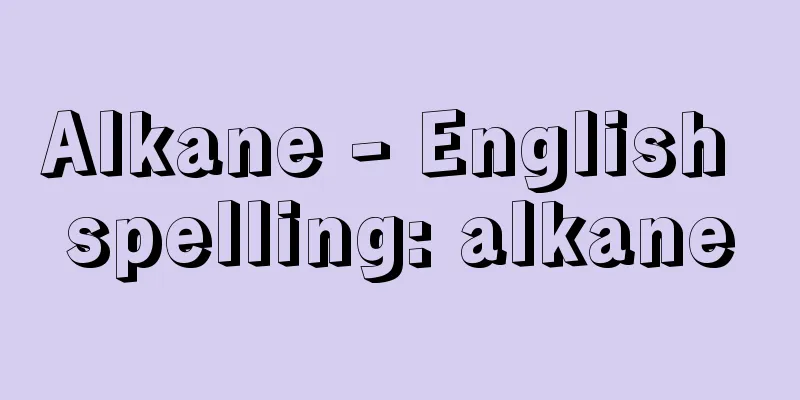Alkane - English spelling: alkane

|
A general term for aliphatic saturated compounds consisting of only carbon (C) and hydrogen (H), with all bonds between the C-C atoms being single bonds, and all remaining valences of the carbon atoms being bonded to hydrogen atoms. It is expressed by the general formula C n H 2 n +2 . Table 1 shows examples where n = 1 to 20. It is also called methane-based hydrocarbons or paraffin-based hydrocarbons. Paraffin is derived from the Latin parum affinis (poor affinity), which indicates that alkanes have poor chemical activity. The length of the C-C single bond is about 1.54 Å (angstroms; 1 Å is 0.1 nanometers), which is longer than the double bond of an alkene (about 1.34 Å) and the triple bond of an alkyne (about 1.20 Å). Alkenes with C=C double bonds and alkynes with C≡C triple bonds in the molecule are called unsaturated compounds. These can be converted to saturated alkanes by hydrogenation using hydrogen and a metal catalyst such as platinum or nickel.
Homologs and IsomersAlkanes can be linear, with carbon atoms linked in a single line, or branched. Straight-chain alkanes are sometimes called n -paraffins (or normal paraffins), and branched alkanes are called isoparaffins. Cyclic saturated hydrocarbons are called cycloalkanes. As the number of carbon atoms in n -alkanes increases, from methane to ethane to propane, the number of -CH 2 - units increases by one. Compounds that differ only in the number of -CH 2 - units are said to be homologs or homologous compounds. shows some examples of typical n -alkanes. Up to propane, which has three carbon atoms, there is only one compound with a corresponding molecular formula ( ), but in butane, which has four carbon atoms, there are compounds with different arrangements of carbon atoms in the molecule. That is, in addition to the linear butane, there is a compound called isobutane. Compounds with the same molecular formula but different arrangements of atoms are called isomers (structural isomers). In this example, we would say that "isobutane is an isomer of butane" or "butane and isobutane are isomers of each other. lists the chemical formulas and melting points and boiling points of structural isomers from butane (C4 ) to hexane (C6 ) , and 2-3 lists the chemical formulas and melting points of structural isomers of heptane (C7 ) . When comparing isomers with the same number of carbon atoms, not only physical properties such as boiling points and melting points but also chemical properties are different. When comparing the boiling points in between isomers with the same number of carbon atoms, in all cases, unbranched n -alkanes have the highest boiling points, and the boiling points decrease as the number of branches increases and the carbon chain becomes shorter. For example, C5 n -pentane has a boiling point of 36°C and is a liquid at room temperature, while the same C5 neopentane has a boiling point of 9.5°C and is a gas at room temperature. shows the relationship between the number of carbon atoms in an alkane and the number of structural isomers. As can be seen, the number of isomers increases as the number of carbon atoms increases. The number of isomers of eicosane, which has 20 carbon atoms, is close to 370,000. As can be seen from the examples in , , and above, it is known that all possible isomers actually exist for lower alkanes with fewer carbon atoms. [Takeo Sato and Masaru Hirota] NomenclatureOrganic compounds are named by introducing various functional groups to the carbon skeleton. Therefore, the naming of alkanes is the basis of the nomenclature of organic compounds. The suffix -ane indicates that they are alkanes. For alkanes with one to four carbon atoms, the conventional names methane, ethane, propane, and butane are used. For alkanes with five or more carbon atoms, the Greek (and some Latin) numerals that represent the number are followed by -ane. For example, an alkane with five carbon atoms is penta + ane = pentane, or pentane. For alkanes with six or fewer carbon atoms, the prefix " n " can be added to indicate that they are straight-chain isomers, such as n -butane, n -pentane, and n -hexane, if necessary. For branched alkanes, the conventional names such as isobutane, isopentane, neopentane, and isohexane may be used for the hydrocarbon names only. In general, branched alkanes are named by considering the longest carbon chain (called the main chain) in the compound to be substituted with an alkyl group. An example of an isomer of octane, which has eight carbon atoms, is shown in In this case, the longest carbon chain is six, so the main chain is hexane, which has six carbon atoms, and the compound is named as its dimethyl-substituted derivative. The radical name obtained by removing one hydrogen from an alkane is created by taking the alkane name and adding -yl. For example, ethane is named ethyl, butane is named butyl, etc. shows the names of linear saturated hydrocarbons and their alkyl groups. [Takeo Sato and Masaru Hirota] Molecular ShapeThe fact that the valence of carbon has a tetrahedral structure was independently proposed by van't Hoff of the Netherlands and Le Bel of France in 1874, and was later proven by physical measurements such as electron diffraction. Methane, the alkane with the simplest structure, has a structure in which, with a carbon atom placed at the center of a regular tetrahedron, a hydrogen atom is located at each vertex, as shown in The angle formed by the hydrogen-carbon-hydrogen atoms is 109.5°, or more precisely, 109°28'. This angle is sometimes called the tetrahedral angle. In ethane, CH3 - CH3, which has two carbon atoms, the two CH3 groups can rotate around the C-C bond. As they rotate, the molecule changes shape regularly. Looking at butane, which is the basis of a chain-like carbon skeleton, the most stable shape (called a conformation) is one in which the two methyl groups at both ends are positioned as far away from each other as shown in This is why carbon chains tend to take on a zigzag shape. In carbon compounds with a tetrahedral structure, when one carbon atom is attached to four different atoms or atomic groups, two types of isomers are possible. These isomers are in a real image and mirror image relationship to each other and are called optical isomers. shows only the number of structural isomers, and the number of isomers increases further when optical isomers are considered. [Takeo Sato and Masaru Hirota] natureshows the relationship between the carbon number of n -alkanes and their boiling and melting points. The boiling points of n -alkanes increase with increasing molecular weight. Alkanes with 1 to 4 carbon atoms are gases at room temperature, but those with 5 to 17 carbon atoms are liquid. Alkanes with more than this number of carbon atoms are solid and waxy. The range of increase in boiling point with increasing carbon number gradually narrows, and the difference between methane and ethane, about 70°C, is 25°C for nonane ( C9H20 ) and decane ( C10H22 ) . Unlike boiling point, melting point depends not only on molecular weight but also on the shape of the molecule and whether the number of carbon atoms is even or odd. The specific gravity of n -alkanes is less than 1, and liquid alkanes are insoluble in water, so they float on water. They dissolve well in organic solvents such as benzene, chloroform, and ether, but their solubility in methanol decreases as the number of carbon atoms in the alkane increases. Alkanes burn in air to become water and carbon dioxide. The heat released during this process is called heat of combustion. For methane, CH 4 + 2O 2 When alkanes are present in the air at a certain concentration range, an explosion will occur if they are ignited. The upper and lower limits of this concentration range are called the explosive limits. shows the ignition temperatures and explosive limits of alkanes. To prevent methane or propane gas explosions in coal mines or indoors, care must be taken to ensure that the gas concentrations do not fall within the explosive range. Alkanes do not react at all with ionic reagents such as concentrated sulfuric acid, concentrated nitric acid, sodium hydroxide, and potassium permanganate, which react well with alkenes and alkynes. They also do not react with halogens when light is blocked, but they react violently with halogens such as chlorine when exposed to light. Taking methane as an example, hydrogen is successively replaced by chlorine atoms, changing as shown in , giving products in which one to four hydrogen atoms in methane are replaced by chlorine. It is known that the reaction of alkanes with halogens by light and the combustion of alkanes with oxygen are both radical chain reactions. In summary, alkanes undergo radical reactions induced by light or heat, but are unlikely to undergo ionic reactions. [Takeo Sato and Masaru Hirota] Manufacturing methodAlkanes can be synthesized in the laboratory using methods such as those shown in . (1) Alkenes or alkynes are hydrogenated using a metal catalyst. For example, alkenes can be easily hydrogenated using a Raney nickel or platinum catalyst to give alkanes (Equation 1). (2) The alkyl halide is reduced using lithium aluminum hydride or sodium amalgam (Equation 2). (3) Reduces ketones and fatty acids (Equation 3). (4) React an alkyl halide with sodium using the Wurtz-Fittig reaction (Equation 4). (5) Decarboxylate saturated fatty acids (Equation 5). (6) Electrolyze the sodium salt of saturated fatty acid (Equation 6). This reaction is called the Kolbe reaction. (7) The Fischer-Tropsch reaction is used. This reaction proceeds by passing carbon monoxide and hydrogen over a catalyst such as cobalt, nickel, or iron, and is an important chemical reaction that produces hydrocarbons from a single carbon atom ( C1) (Equation 7). [Takeo Sato and Masaru Hirota] resourceAlkanes are mainly obtained from petroleum and natural gas. They are produced by the decomposition of organic matter accumulated by plants and animals in prehistoric times. Depending on the place of origin, petroleum is composed of alkanes with carbon numbers from 2 to 40 as the main components, as well as cycloalkanes, aromatic hydrocarbons, and heterocyclic compounds, making it an important hydrocarbon resource. Extracted petroleum crude oil is converted into low molecular weight hydrocarbons through processes such as catalytic cracking and hydrocracking, and is used as fuels such as gasoline, kerosene, diesel, and heavy oil, which are indispensable in modern life, and as a raw material for the petrochemical industry. The main component of gasoline is alkanes, and the ratio of alkanes contained in gasoline varies from 30 to 100%, depending on the manufacturing method and place of origin. In the petroleum refining process, catalysts are used to cut long carbon chains to low molecular weights, or to isomerize to increase the number of branched hydrocarbons. In the petrochemical industry, alkanes are converted into useful alkenes through processes such as naphtha cracking to create raw materials for various chemical industrial products. Natural gas is composed mainly of the low molecular weight alkanes methane and ethane, with small amounts of propane and butane. Methane is also called swamp gas because it is produced in swamps by anaerobic fermentation from dead plants in the water, such as fallen leaves, and is extracted as a resource from underground gas fields. It has also been discovered that large amounts of methane combine with water and exist in the deep sea in the form of "methane hydrate," and this is attracting attention as a promising energy resource. [Takeo Sato and Masaru Hirota] "Organic Chemistry" by Debut and Reinhart, translated by Kengo Shiomi, Yutaka Hirota, and Kiyoshi Tsumitai (1971, Kyoritsu Shuppan)" ▽ "New Introduction to Organic Chemistry" by Kiyoshi Tsumitai (2000, Asakura Shoten) [References] | | | | | | | | | | | |From left: methane, ethane, and propane. ©Shogakukan "> Molecular model of alkane ©Shogakukan "> Representative examples of n-alkanes (Table 1) ©Shogakukan "> C to C alkanes (Table 2-1) ©Shogakukan "> C to C alkane isomers (Table 2-2) ©Shogakukan "> C alkane isomers (Table 2-3) ©Shogakukan "> Carbon number and number of structural isomers [Table 3] ©Shogakukan "> Nomenclature of branched alkanes (Figure A) Note: The names of the substituents that result from removing one hydrogen atom from an alkane are also listed . ©Shogakukan Names of saturated chain hydrocarbons and alkyl groups [Table 4... ©Shogakukan "> Structure of methane (Figure B) ©Shogakukan "> Shape of butane molecule (Figure C) Note: Andrew Streitwieser & Clayton H. Heathcock, Collier Macmillan, 1976 ©Shogakukan Boiling points and melting points of n-alkanes (Figure D) ©Shogakukan "> Ignition temperatures and explosion limits of alkanes (Table 5) ©Shogakukan "> Photochlorination reaction (Fig. E) ©Shogakukan "> Synthesis of Alkanes (Table 6) Source: Shogakukan Encyclopedia Nipponica About Encyclopedia Nipponica Information | Legend |
|
炭素Cと水素Hのみからなり、C-C原子間の結合がすべて単結合で、炭素原子の残りの原子価はすべて水素原子と結合した脂肪族飽和化合物の総称。一般式CnH2n+2で表される。表1にn=1~20の例を示す。メタン系炭化水素あるいはパラフィン系炭化水素ともよばれる。パラフィンとはラテン語でのparum affinis(親和力に乏しい)に由来し、アルカンが化学的活性に乏しいことを表している。C-C単結合の長さは1.54Å(オングストローム。1Åは0.1ナノメートル)程度で、アルケンの二重結合(1.34Å程度)、アルキンの三重結合(1.20Å程度)よりも長い。分子内にC=C二重結合をもつアルケンや、C≡C三重結合をもつアルキンは不飽和化合物とよばれる。これらは水素と白金、ニッケルなどの金属触媒を用いて水素添加することにより、飽和化合物であるアルカンに導くことができる。
同族体と異性体アルカンには炭素原子が一列につながっている直鎖状のものと、炭素鎖が枝分れしたものがある。直鎖状のものをn-パラフィン(または正パラフィン)、枝分れしたものをイソパラフィンとよぶことがある。環状の飽和炭化水素はシクロアルカンとよばれる。 n-アルカンはメタンからエタン、プロパンと炭素数が増加するにつれて-CH2-単位が一つずつ増える。このように-CH2-の数だけが異なる化合物を、互いに同族体あるいは同族列化合物であるという。に代表的なn-アルカンの例を示す。 炭素数3のプロパンまでは分子式に対応する化合物は一つずつしかないが()、炭素数4のブタンでは分子内での炭素原子の配列が異なる化合物が存在する。すなわち、直鎖状のブタンのほかにイソブタンとよばれる化合物がある。このように同じ分子式をもちながら異なる原子配列をとっている化合物を異性体(構造異性体)という。この例では「イソブタンはブタンの異性体である」または「ブタンとイソブタンは互いに異性体の関係にある」のようにいう。にC4のブタンからC6のヘキサンまで、にC7のヘプタンの構造異性体の化学式と融点・沸点を掲げる。同じ炭素数の異性体を比べると、沸点、融点などの物理的性質だけでなく化学的性質も異なっている。の沸点を、同じ炭素数の異性体の間で比べてみると、すべての場合で、枝分れのないn-アルカンがもっとも高い沸点で、枝分れが多くなり炭素鎖が短くなるにしたがって沸点が低くなっている。たとえばC5のn-ペンタンは沸点が36℃で常温では液体であるが、同じC5でもネオペンタンは沸点が9.5℃で常温では気体である。にアルカンの炭素数と構造異性体数の関係を示す。このように炭素数が増えるにしたがって異性体数は増大する。炭素数20のエイコサンの異性体は37万に近い。前記の、、の例からわかるように、炭素の少ない低級のアルカンについては可能な異性体はすべて実際に存在することが知られている。 [佐藤武雄・廣田 穰] 命名法有機化合物は、炭素骨格に各種の官能基が導入されたものとして命名される。したがってアルカンの命名は有機化合物の命名法の基本となる。アルカンであることを示す接尾語は-ane(アン)である。炭素数1から4までのアルカンには慣用のメタン、エタン、プロパン、ブタンという名称を用いる。炭素数5以上の場合は、数を表すギリシア語(一部ラテン語)の数詞に-aneをつけて命名する。たとえば炭素数5のものはpenta+ane=pentane、ペンタンとなる。炭素数6以下のアルカンについては、必要な場合にはn-ブタン、n-ペンタン、n-ヘキサンのように接頭語「n」をつけて直鎖の異性体であることを表記できる。枝分れアルカンについては、炭化水素名に限ってイソブタン、イソペンタン、ネオペンタン、イソヘキサンなどの慣用名を使ってもよい。一般に枝分れのあるアルカンを命名する方法は、化合物中でもっとも長い炭素鎖(主鎖という)に、アルキル基が置換したものと考えて命名する。炭素数8のオクタンの異性体の例をあげると、のようになる。 この場合、もっとも長い炭素鎖は6であるので、炭素数6のヘキサンを主鎖としてそのジメチル置換体として命名するわけである。 アルカンの水素一つを取り除いた基名はアルカン名から-aneをとり-yl(イル)をつけて命名する。すなわち、エタンethane→エチルethyl、ブタンbutane→ブチルbutylのように命名する。に鎖状飽和炭化水素名とアルキル基名を示す。 [佐藤武雄・廣田 穰] 分子の形炭素の原子価が四面体構造をもつことは、すでに1874年にオランダのファント・ホッフとフランスのル・ベルによって独立に提案され、その後電子線回折などの物理的測定により実証された。もっとも簡単な構造のアルカンであるメタンは、に示すように正四面体の中心に炭素原子を置くと、各頂点に水素原子が位置する構造をしている。水素―炭素―水素各原子がつくる角は、109.5°、より精確には109°28′である。この角度を四面体角とよぶことがある。 二つの炭素原子をもつエタンCH3-CH3では二つのCH3基がC-C結合の周りで回転できる。回転に伴い分子は規則的に形が変わる。鎖状の炭素骨格の基本となるブタンについてみると、もっとも安定な形(立体配座という)はに示すように両端にある二つのメチル基が互いにもっとも離れた位置をとる。炭素の鎖がジグザグ形をとりやすいのはこのためである。 四面体構造をもつ炭素化合物では、一つの炭素原子に4種の異なる原子あるいは原子団がつくと、2種類の異性体が可能となる。この異性体は互いに、実像と鏡像の関係にあり、光学異性体とよばれる。は構造異性体数のみを示してあり、光学異性体を考えるとさらに異性体の数は増大する。 [佐藤武雄・廣田 穰] 性質にn-アルカンの炭素数と沸点および融点との関係を示す。n-アルカンの沸点は分子量の増大に伴って上昇する。炭素数1から4のアルカンは常温で気体だが、炭素数5から17では液体となる。それ以上の炭素数のアルカンは固体で蝋(ろう)状の物質である。炭素数の増大に伴う沸点上昇の幅はしだいに狭まり、メタンとエタンの差約70℃はノナンC9H20とデカンC10H22では25℃になる。融点は沸点と異なり分子量以外に分子の形、炭素数の偶数か奇数かなどに依存していることがわかる。n-アルカンの比重は1より小さく、液体のアルカンは水に溶けないので水に浮く。ベンジン、クロロホルム、エーテルなどの有機溶媒にはよく溶けるが、メタノールへの溶解度はアルカンの炭素数が多くなるにしたがって減少する。 アルカンは空気中で燃焼して水と二酸化炭素になる。この際放出される熱量を燃焼熱という。メタンでは 空気中に一定の範囲内の濃度のアルカンが存在すると、点火した場合に爆発がおこる。この濃度範囲の上限と下限を爆発限界という。にアルカンの発火温度と爆発限界を示す。炭坑や室内でメタンやプロパンガスの爆発がおこらないようにするには、爆発範囲のガス濃度にならないように注意する必要がある。 アルカンは、アルケンやアルキンとよく反応する濃硫酸、濃硝酸、水酸化ナトリウム、過マンガン酸カリウムなどのイオン性試薬とはまったく反応しない。光を遮断した状態ではハロゲンとも反応しないが、光照射下では塩素などのハロゲンと激しく反応する。メタンを例にとると、水素を次々と塩素原子で置換し、のように変化して、メタンの水素原子が1~4個の塩素により置換された生成物を与える。 光によるアルカンとハロゲンとの反応、アルカンが酸素により燃焼する反応は、ともにラジカル連鎖反応であることが知られている。まとめとして、アルカンは光や熱により誘発されたラジカル的反応をするが、イオン的な反応はおこしにくいということができる。 [佐藤武雄・廣田 穰] 製法実験室でアルカンを合成するにはに例を示すような方法が用いられる。 (1)アルケンあるいはアルキンを金属触媒を用いて水素添加する。たとえば、アルケンはラネーニッケル触媒や白金触媒を用いて接触水素化を行うと容易にアルカンを与える(式1)。 (2)ハロゲン化アルキルを水素化アルミニウムリチウムまたはナトリウムアマルガムを用いて還元する(式2)。 (3)ケトンや脂肪酸を還元する(式3)。 (4)ウルツ‐フィティッヒ反応を用い、ハロゲン化アルキルとナトリウムを反応させる(式4)。 (5)飽和脂肪酸を脱炭酸する(式5)。 (6)飽和脂肪酸のナトリウム塩を電気分解する(式6)。この反応をコルベ反応という。 (7)フィッシャー‐トロプシュ反応を利用する。この反応はコバルト、ニッケル、鉄などの触媒上に、一酸化炭素と水素を通じることによって進行し、炭素1個C1から炭化水素をつくる化学反応として重要である(式7)。 [佐藤武雄・廣田 穰] 資源アルカンはおもに石油と天然ガスから得られる。これらは有史以前に動植物が蓄積した有機物が分解して生成したものである。産地により異なるが、石油は炭素数2から40ぐらいまでのアルカンを主成分として含むほかに、シクロアルカン、芳香族炭化水素、複素環式化合物から構成されていて、炭化水素の重要な資源である。採掘された石油原油は、接触分解や水素化分解の行程を経て低分子量の炭化水素に変えられ、現代の生活に欠かせないガソリン、灯油、軽油、重油などの燃料や石油化学工業原料として使われている。ガソリンの主成分はアルカンで、含まれるアルカンの比率はガソリンの製法や産地により異なり、30~100%である。石油精製のプロセスでは、触媒を用いて、長い炭素鎖を切断して低分子量にしたり、異性化させて枝分れの多い炭化水素を増やしたりする。石油化学工業では、ナフサ分解などの行程を経て、アルカンを有用なアルケンに変えて種々の化学工業製品の原料をつくっている。天然ガスは低分子量のアルカンであるメタンとエタンが主成分で、少量のプロパン、ブタンを含んでいる。メタンは、沼地で落ち葉など水中で枯死した植物から嫌気性発酵により発生するので沼気(しょうき)ともよばれているが、資源としては地下のガス田から採掘する。多量のメタンが水と結合して「メタンハイドレート」の形で深海に存在することもわかり、有望なエネルギー資源として注目されている。 [佐藤武雄・廣田 穰] 『デビュー、ラインハート著、塩見賢吾、廣田穣、務台潔訳『有機化学』(1971・共立出版)』▽『務台潔著『新有機化学概論』(2000・朝倉書店)』 [参照項目] | | | | | | | | | | | |左から、メタン、エタン、プロパン©Shogakukan"> アルカンの分子模型 ©Shogakukan"> 代表的なn-アルカンの例〔表1〕 ©Shogakukan"> C~Cアルカン〔表2-1〕 ©Shogakukan"> C~Cアルカンの異性体〔表2-2〕 ©Shogakukan"> Cアルカンの異性体〔表2-3〕 ©Shogakukan"> 炭素数と構造異性体数〔表3〕 ©Shogakukan"> 枝分れアルカンの命名法〔図A〕 注:アルカンから水素原子を一つとった構造の置換基名もあわせて記載©Shogakukan"> 鎖式飽和炭化水素名とアルキル基名〔表4… ©Shogakukan"> メタンの構造〔図B〕 ©Shogakukan"> ブタン分子の形〔図C〕 注:Andrew Streitwieser & Clayton H. Heathcock “” Collier Macmillan社刊(1976)より©Shogakukan"> n-アルカンの沸点と融点〔図D〕 ©Shogakukan"> アルカンの発火温度と爆発限界〔表5〕 ©Shogakukan"> 光塩素化反応〔図E〕 ©Shogakukan"> アルカンの合成法〔表6〕 出典 小学館 日本大百科全書(ニッポニカ)日本大百科全書(ニッポニカ)について 情報 | 凡例 |
>>: Alkaloids - Arukaroido (English spelling)
Recommend
Nereides (English spelling)
… According to Greek mythology, the sea Pontus wa...
Chromaticity - Shikido
Chromaticity is a term used to describe the proper...
Oil sands - Oil sand
This refers to sand that contains viscous hydroca...
The 88th night
One of the miscellaneous festivals in the calenda...
Charles Robert Ashbee
1863‐1942 British architect and designer. One of t...
Permanent teeth
These are teeth that replace milk teeth and do not...
Cairo Declaration
On November 27, 1943, on the final day of the Firs...
Pyatakov, GL (English spelling) PyatakovGL
...In September 1936, when Yezhov, a bureaucrat i...
neuroscience
…Neurology is a discipline that was established a...
Chang Po‐go (English spelling)
?‐841 A maritime merchant and local general in Kor...
Achilles - Achilles
…He was a man of great learning and deep affectio...
Founder/Founder - Kaisankaiki
It refers to the founding of a Buddhist temple, an...
Funambulus palmarum
…[Yoshiharu Imaizumi]. … *Some of the terminology...
Igamono - Igamono
A general term for those who were local samurai o...
Viverra tangalunga (English notation) Viverratangalunga
… Civet Spirit Cat Incense [Imaizumi Tadaaki]. . ...









